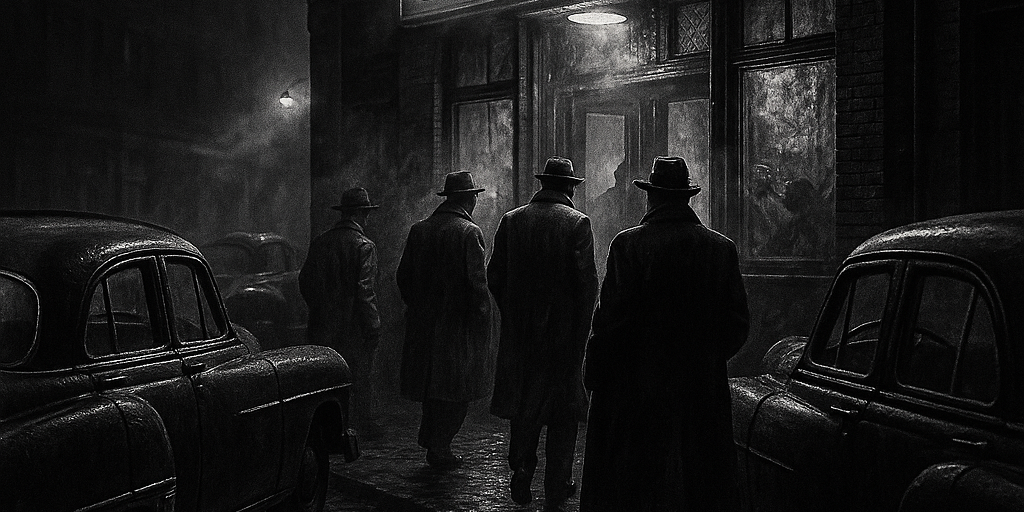Mobsters of Pittsburgh: The LaRocca Era and the Rise of Organized Crime
In the smoke-filled back rooms of Pittsburgh’s working-class neighborhoods, amid the clinking glasses and whispered deals of its social clubs, a quiet but ruthless empire was born. Pittsburgh’s mafia history often sits in the shadow of more famous cities like New York and Chicago, but Steel City mobsters, particularly during the LaRocca era, crafted an organized crime network as influential and complex as any in America. Here’s the fascinating, gritty, and occasionally darkly humorous tale of how Pittsburgh became a mobster hub during the reign of boss John LaRocca.
The Roots of Pittsburgh’s Underworld
Pittsburgh has always been a blue-collar city. Grit, work ethic, and quiet strength are part of the local DNA. That same hardworking spirit extended, oddly enough, into its criminal underworld.
During the early 20th century, thousands of Italian immigrants settled in neighborhoods like Bloomfield, Larimer, and the Hill District. With them came traditions from the old country — some good, some shady. Pittsburgh’s early mafia roots can be traced back to Sicilian and Calabrian immigrants who brought the “Black Hand” extortion tactics to the city. These rudimentary rackets targeted fellow immigrants and small business owners, setting the foundation for a more organized operation.
By the 1920s and ’30s, Prohibition threw gasoline on the fire. Like many cities, Pittsburgh became a hotbed for bootlegging, illegal bars, and whiskey smuggling. The Ohio, Allegheny, and Monongahela rivers made Pittsburgh a convenient transportation hub for illicit booze. This era gave rise to early mob leaders like Giuseppe “Joe the Baron” Siragusa and Frank Amato, whose operations would pave the way for a new kingpin: John LaRocca.
Enter John LaRocca: From Shoemaker to Street Boss
John Sebastian LaRocca was born in Sicily in 1901 and immigrated to the U.S. as a teenager, eventually settling in the Pittsburgh area. He started out working humbly as a shoemaker, but ambition and opportunity soon lured him into bootlegging and illegal gambling.
LaRocca was disciplined, cautious, and calculating. Unlike other mobsters who craved headlines, he craved longevity. As law enforcement cracked down on loud, violent figures, LaRocca flew under the radar — quietly building influence, avoiding messy wars, and making all the right connections.
By the early 1950s, he had ascended to become the undisputed boss of the Pittsburgh mafia, which by then was part of a loosely affiliated nationwide criminal network.
The LaRocca Crime Family: Structure, Territory, and Strategy
LaRocca’s organization wasn’t flashy — it was effective. Operating under what would later be dubbed the “LaRocca Crime Family,” Pittsburgh’s mob kept its operations tightly knit and deeply local. Territory covered all of western Pennsylvania, parts of eastern Ohio, and parts of West Virginia.
The family operated with a traditional hierarchy:
- Boss: John LaRocca
- Underboss: Michael Genovese (no relation to the NYC family)
- Consigliere: Gabriel “Kelly” Mannarino
- Capos, Soldiers, and Associates: Managed local crews running gambling, rackets, and collections.
What made LaRocca different was his discretion. His family wasn’t marked by shootouts in the streets — it was marked by quiet intimidation, political influence, and economic entrenchment.
Gambling: The Family’s Cash Machine
By the 1950s and ’60s, Pittsburgh was flush with illegal gambling. Numbers games (a kind of underground lottery) were especially popular in the Hill District and other working-class areas. Bars, convenience stores, and barber shops often served as fronts.
Illegal casinos dotted the outskirts of the city, some well-known in the community. The mob also had its hooks in sports betting and high-stakes poker games. Enforcement was rarely needed — the locals paid up because they trusted the system. And if they didn’t? Let’s just say people remembered the consequences.
At its peak, the LaRocca Family was making millions annually from gambling alone — almost entirely tax-free.
Labor Unions: Power Through Influence
Another key revenue stream was labor racketeering. LaRocca’s crew exerted influence over construction, trucking, longshoremen, and even some steelworker unions. They controlled hiring halls, collected dues, and skimmed profits from benefit funds.
In some cases, mob-controlled unions would extort businesses through threats of strikes or sabotage. Companies often paid “labor peace” money to ensure smooth operations. This blend of legitimate influence and illegitimate threat made the LaRocca Family both powerful and hard to prosecute.
The teamsters, in particular, had mob fingerprints. Though most of that attention went to Jimmy Hoffa in Detroit, Pittsburgh’s share of the pie was substantial.
National Ties: LaRocca on The Commission
LaRocca’s calm demeanor and reliability earned him a seat at the highest table of organized crime: The Commission— a governing council of the major American mafia families. It included bosses from New York, Chicago, Buffalo, and Cleveland. Pittsburgh’s seat at this table meant LaRocca could broker disputes, share resources, and protect his turf.
He built strong ties with figures like:
- Carlo Gambino (New York)
- Tony Accardo (Chicago)
- Russell Bufalino (Pennsylvania)
This helped the Pittsburgh family expand into Florida, New Orleans, and even Las Vegas through partnerships and investments.
Notable Figures: The Crew Behind the Curtain
LaRocca surrounded himself with smart, loyal lieutenants:
- Michael Genovese: Succeeded LaRocca as boss. Known for being even more low-profile.
- Gabriel “Kelly” Mannarino: Operated in New Kensington and ran major gambling hubs.
- Charles “Chucky” Porter: Later became an FBI informant in the 1990s, providing unprecedented detail on the family’s operations.
Their success rested not on flair, but on blending in. Most Pittsburgh mobsters lived in modest homes and sent their kids to Catholic school. They looked like regular yinzers — until you crossed them.
Anecdotes and Urban Legends
Pittsburghers who lived through the ’50s–’70s all have stories.
One man tells of the bar in Bloomfield where everyone knew not to sit at the last booth — that was reserved for the man collecting numbers. Another recalls seeing a man get dragged out of a VFW hall for refusing to pay a gambling debt — only to return the next week, smiling, with a black eye and the money.
And of course, there’s the famous “second-story bar meeting” — where it’s said LaRocca once had a sit-down with a union boss and a U.S. senator (unnamed in reports), hammering out a deal over cigars and whiskey.
Decline and Fall: From Power to Paranoia
John LaRocca died in 1984 of natural causes — a rarity among mob bosses. Michael Genovese took over and tried to maintain the old code, but times had changed. Law enforcement tactics improved. Surveillance tech advanced. Wiretaps, RICO laws, and turncoat informants eroded the mafia’s power base.
One of the biggest blows came in the 1990s, when underboss Charles “Chucky” Porter flipped, becoming the highest-ranking Pittsburgh mobster to cooperate with the feds. His testimony helped dismantle the remaining infrastructure of the LaRocca Family.
Legacy: What Remains Today
Though the mafia’s formal power in Pittsburgh is all but gone, the legacy of LaRocca’s reign remains. You’ll still find high-water marks of that era:
- Small clubs and bars with secret rooms.
- Families who still whisper about “Uncle Tony’s connections.”
- Old-timers who nod knowingly when names like Mannarino are mentioned.
The Pittsburgh mafia may not have made national headlines, but it was effective, influential, and deeply local. Its members didn’t crave celebrity — they craved control. And for a time, they had it.
More Dons, Turf Wars, and Hidden Histories
The LaRocca family didn’t rise in a vacuum. Explore our full Pittsburgh Mafia & Crime History collection to uncover the power struggles, alliances, and betrayals that shaped Pittsburgh’s criminal empire.
From early underworld figures like John Bazzano to the city’s most brazen heists and outlaw legends, this hub reveals how organized crime evolved—and endured—in the Steel City.
Explore the Full Crime History →








